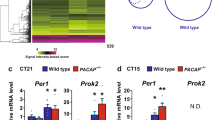Abstract
To examine the effects of cervical sympathectomy on the transport of gonadotropin-releasing hormone (GnRH) between the hypothalamic neurons and the median eminence, 16 male rats were assigned into four groups: control (C), light (L), light-sympathectomy (LS), and light-colchicine (LC). The C group was kept under a normal circadian rhythm for 2 weeks, and the L group was kept under continuous exposure to light for the same period. The LS group underwent bilateral cervical sympathectomy before being kept under continuous light conditions for 2 weeks. The LC group received colchicine into the cerebral ventricle after being kept under continuous light for 12 days; subsequently, this group was also housed for 2 days under continous light. After these procedures, blood was collected and serum luteinizing hormone (LH) levels were measured. All rats were perfused with a fixative, and GnRH neurons around the anterior commissure, as well as GnRH fibers and granules in the median eminence, were stained immunohistochemically. The L group showed a decreased number of GnRH neurons, increased concentrations of GnRH fibers and granules, and an increased LH level; however, in the LS and LC groups, these changes were not seen. The response in the LS group resembled that in the LC group. Considering the action of colchicine, which inhibits axonal transport, it is suggested that cervical sympathectomy also inhibits axonal transports of GnRH between the GnRH neurons and the median eminence during continuous exposure to light.
Similar content being viewed by others
References
Iwama H, Tase C, Tonosaki Y, Sugiura Y (1995) Cervical sympathectomy affects gonadotropin-releasing hormone, luteinizing hormone and testosterone in male rats. J Anesth 9: 166–169
Guesdon J-L, Ternynck T, Avrameas S (1979) The use of avidinbiotin interaction in immunoenzymatic techniques. J Histochem Cytochem 27: 1131–1139
Karlsson JO, Sjöstrand J (1969) The effect of colchicine on the axonal transport of protein in the optic nerve and tract of the rabbit. Brain Res 13: 617–619
Chiocchio SR, Cardinali DP, Vacas MI, Tramezzani JH (1984) Acute superior cervical ganglionectomy depresses the postcastration rise of gonadotropins in male rats. Brain Res 309: 354–356
Romeo HE, Arias P, Szwarefarb B, Moguilevsky JA, Cardinali DP (1991) Hypothalamic luteinizing hormon-releasing content and serum luteinizing hormone levels in male rats during wallerian degeneration of sympathetic nerve terminals after superior cervical ganglionectomy. J Neural Transm Gen Sect 85: 41–49
Author information
Authors and Affiliations
About this article
Cite this article
Iwama, H., Tase, C. Cervical sympathectomy inhibits axonal transport of gonadotropin-releasing hormone during continuous exposure to light in male rats. J Anesth 10, 185–189 (1996). https://doi.org/10.1007/BF02471388
Received:
Accepted:
Issue Date:
DOI: https://doi.org/10.1007/BF02471388




